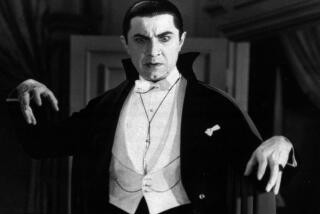BOOK REVIEWS : Mamet Steps Down From Shrine
Some Freaks by David Mamet (Viking: $16.95; 182 pages).
Admire David Mamet and youâll get your head bitten off, or at the very least, a cigar in the face.
There he is on the book jacket, glowering from his car window, half his face in shadow. If you are a cop whoâd stopped him for a broken tail-light, youâd return to the cruiser and radio for back-up. If you are his wife, youâd take the garbage out yourself, and make sure not to walk between him and the TV set.
Such, more or less, is the image suggested in this assorted collection of articles, addresses, musings and rumbles. Mamet is virtually a poet of the theater, drawing a musical sweet haplessness out of his sharpies and dummies. He doesnât thank you to say so.
âI am a card-carrying member of the ACLU and the NRA and I never signed up to be sensitive,â he writes in a piece about playing poker with the boys.
Attending a convention of counterinsurgency groupies sponsored by Soldier of Fortune magazine, he frets that his Oxford shirt and blue jeans will mark him as âanother wussy Eastern intellectual with a marvelous gift for dialogue.â
He takes part wholeheartedly, shooting off a pistol and entering the pugil stick contest. He knocks his first opponent into the swimming pool, and is knocked over by the second, though not before overpowering him in the preliminary ritual scream.
âLovely people,â he writes of the conventioneers, even if he doesnât agree with some of their ideas. âBut then I donât agree with some of my own ideas and seem powerless to rid myself of them.â And he adds that they âseemed to love the idea of America in much the same way that someone else might love the idea of the Theater--that is, as a perfect institution.â
By rights, that last half-phrase would qualify as sensitive, and maybe brilliant. But Mamet, one of our authentic theater artists, may have made his bed but he will not be caught dead lying in it. In these assorted pieces, he hacks away at any hint of enshrinement.
He tells the Signet Society at Harvard--he must have jumped at the chance to perform the lion in a den of sensitive Daniels--that if he became an artist it was not mainly because of talent or message. Perhaps it was âto accommodate and embrace a deviant personality which was not going to be employed elsewhere.â If youâre a left-handed plumber, in other words, you do left-handed pipe-bends.
It can be as tedious for an artist to flaunt his hairy chest as his hair shirt. Mametâs art, in any case, does not principally lie in writing such occasional pieces as are collected here in âSome Freaks.â Many are as rough in workmanship as in message; there is a lot of sounding off and putting the feet up. It makes the feet feel good, but readers arenât feet.
Aside from eight or nine pieces too slight or ephemeral to survive collecting, Mamet usually has something worthwhile, or arresting, or bruising to say. He is witty and idiosyncratic for part of the trip. The trick is to get off in time. The stop after idiosyncrasy is sententiousness.
Mametâs notes on being a first-time film director--âHouse of Gamesâ--nicely distinguish those things a director can do from those he should submit to. Sometimes, a generalâs job is simply to be seen on his white horse. Mamet writes of stepping ceremonially up to the viewfinder for each shot--at this stage, the real responsibility belongs to the cinematographer--and ostentatiously reversing the bill on his cap.
Discussing acting for TV, he advises the performer to do little. The script will furnish the characterization, he writes. Acting technique should aim âto render the actor sufficiently uninflected to allow the audience to accept him in a multiplicity of roles.â
Two of the pieces denounce what Mamet sees as the tendency of American Jews to downplay their Jewishness. Reform Judaism, in particular, he calls âreligion in a plain brown wrapper, the selling point of which was that it would not embarrass us.â
He argues that American Jews are dedicated to speaking up for civil rights and social equality for all minority groups except their own. Young Jewish women of his generation, he writes, flocked to enroll in Black Studies programs. And their friends and families, he adds, âsupported them in their support of Black self-love at the same time we supported them in surgically recarving their faces so that they would look less âJewish.â â
There is a brutal wit here--it sounds like Jackie Mason--but it seems a partial view, to say the least, and considering the backlash among Jewish voters to the Rev. Jesse Jackson, partly outdated.
It is also hard to know what he means when he laments that Jewish houses look like Yankee houses and have no visual identity. What would a specifically Jewish house look like? What, for that matter, would a specifically Catholic house look like? If you want to be fundamental about it: like tents, both of them.
More to Read
Sign up for our Book Club newsletter
Get the latest news, events and more from the Los Angeles Times Book Club, and help us get L.A. reading and talking.
You may occasionally receive promotional content from the Los Angeles Times.







